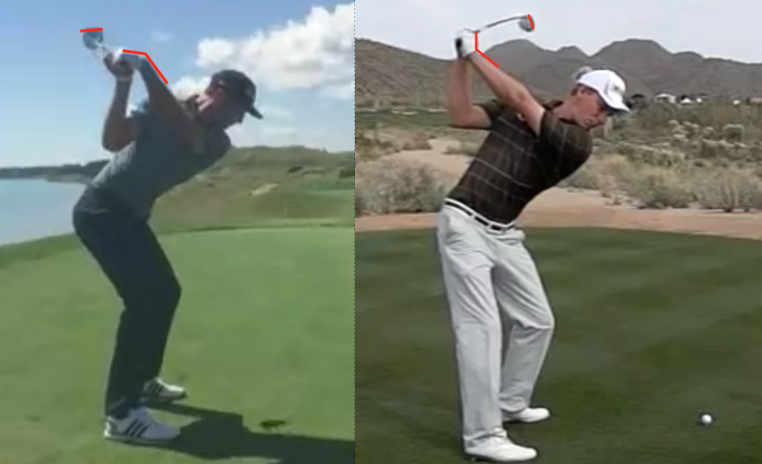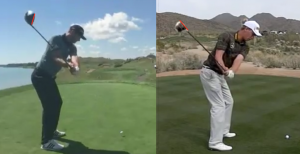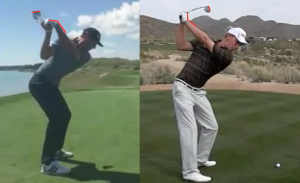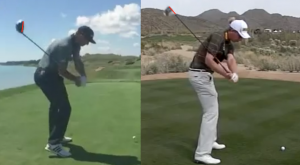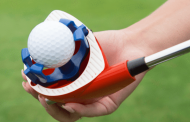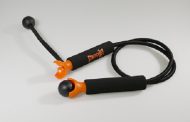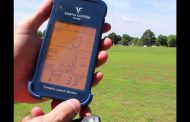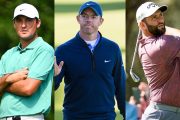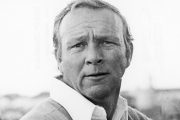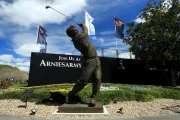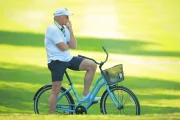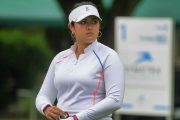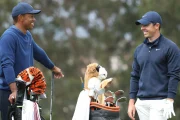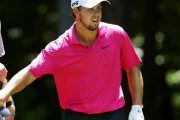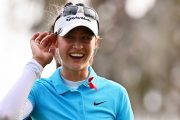While the club plane and club path are often the most talked about technical aspects of the golf swing, people often forget that the clubface is actually the most influential impact factor when it comes to deciding the starting direction and curvature of the golf ball. When most golfers have an issue with where the ball is going they will often jump to the conclusion that the path of the club is the key to correcting such an issue, yet the club face is often far more important, and far easier to improve the direction of the ball.
“The golf ball will always start somewhere between the club face angle and the club path, but closer to the club face angle (providing a centred strike). The ball will always curve away from the path, towards the direction of the club face.”
To put the above into context we must look at how the club will move in the golf swing to create these club face positions at impact. Below we have two completely opposite style of players. Dustin Johnson is the longest hitter on the PGA Tour and shapes the ball strongly from right to left (draw shape). Marcel Siem plays on the European tour and plays with a distinct left to right curvature on the golf ball (fade shape). Despite these differences, both players have competed at the highest level of the game, and continue to do so with great success.
As we look at both players as they take the club away from the golf ball you will instantly see a very different look to both players, none more noticeable than in the positioning of the club face. As we look at Dustin Johnson on the left, we can see the club face is distinctly closed as it moves away from the golf ball and the face of the club points downwards. Almost in total contrast, Marcel Siem on the right hand side would be declared to have a more open club face position which points almost towards the sky at this point in the golf swing.
Despite these positions being deemed slightly “open” or “closed” it must be noted that both can change at various points in the golf swing, and just because they may begin in this way it does not mean they will approach the golf ball in this way.
As we look at the top of the backswing again we can see a startling difference with both the club face position and the wrist position shown by both players. The wrist position is particularly important to take note of as it has an enormous impact on the club face orientation throughout the swing. As we look at Johnson on the left hand side you will see he displays what we would call a bowed left wrist, whereby the back of the hand points towards the sky. As a result of this you will also see the club face replicates such a position, and reaches quite a closed position at the top.
As you look at Siem’s wrist position it is in the complete opposite position at the top of the backswing. His wrist would be deemed to be in a cupped position, where we see a smaller angle created between the back of the left hand and his left forearm. This will force the club into a more open position which is ideal for curving the ball from left to right.
As the club travels down we now begin to see the most important club face positions in the swing. The reason I say this is that at this point there is a minimal amount of time to change the face orientation before impact. Looking at Dustin Johnson you will see that as the golf club approaches the golf ball the face is quite in a closed position which will produce a draw providing he combines it with an in to out club path.
As we look at Marcel Siem on the other hand we see the club face is in an open position as it approaches the golf ball, and in total contrast to Dustin, this open face position will produce a fade providing Marcel is able to produce an out to in path through impact.
Having an awareness of the club face position in the swing is an essential part of producing great golf shots. If you understand and apply these simple rules to your swing you can significantly improve the accuracy and consistency of your golf shots.


